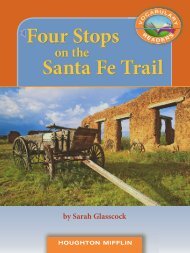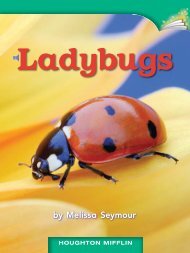Lesson 10:Saving the Mexican Wolves
Lesson 10:Saving the Mexican Wolves
Lesson 10:Saving the Mexican Wolves
- No tags were found...
You also want an ePaper? Increase the reach of your titles
YUMPU automatically turns print PDFs into web optimized ePapers that Google loves.
More captive-bred wolves were released. The wolves beganhaving pups in <strong>the</strong> wild. Yet <strong>the</strong>y continued to run into problems.The biggest threat to wolves continued to be people.Some <strong>Mexican</strong> wolves wandered onto highways and were hit bycars. O<strong>the</strong>rs were shot. At least one was killed by a mountainlion. Some of <strong>the</strong>m wandered out of <strong>the</strong> Blue Range WolfRecovery Area and had to be recaptured.Conservation groups and o<strong>the</strong>rs continued working tokeep <strong>the</strong> reintroduced lobos safe. They began paying ranchersfor cattle or sheep that were killed by wolves. And since wolveswill sometimes eat animals that are already dead, ranchers wereencouraged to remove livestock carcasses so that wolveswouldn’t be attracted to <strong>the</strong>m.Sometimes wolves were shot because people mistook <strong>the</strong>mfor coyotes. Coyotes are common in <strong>the</strong> Southwest, and <strong>the</strong>y doharm livestock. That’s why educating <strong>the</strong> public is an importantpart of <strong>the</strong> reintroduction effort. People need to learn <strong>the</strong>differences between coyotes and <strong>Mexican</strong> wolves. Educationcan also help people understand wolves’ place in <strong>the</strong> ecosystem.Because wolves are an apex predator, <strong>the</strong>y can actually keepcoyotes away from an area. Knowing this may persuade peopleto protect <strong>the</strong> wolves.14
















